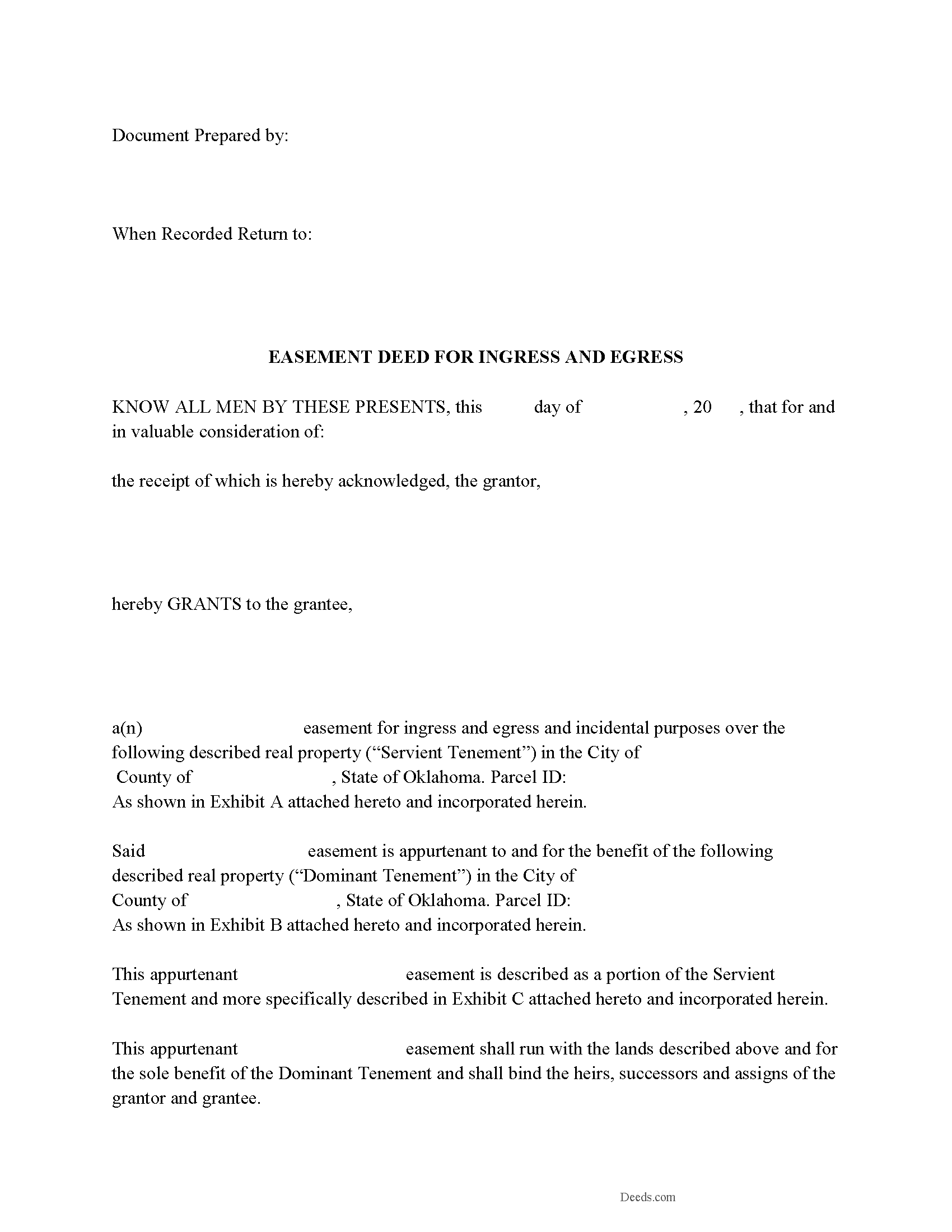Oklahoma Easement Deed
County Forms
Where is the property located?
Adair CountyAlfalfa CountyAtoka CountyBeaver CountyBeckham CountyBlaine CountyBryan CountyCaddo CountyCanadian CountyCarter CountyCherokee CountyChoctaw CountyCimarron CountyCleveland CountyCoal CountyComanche CountyCotton CountyCraig CountyCreek CountyCuster CountyDelaware CountyDewey CountyEllis CountyGarfield CountyGarvin CountyGrady CountyGrant CountyGreer CountyHarmon CountyHarper CountyHaskell CountyHughes CountyJackson CountyJefferson CountyJohnston CountyKay CountyKingfisher CountyKiowa CountyLatimer CountyLe Flore CountyLincoln CountyLogan CountyLove CountyMajor CountyMarshall CountyMayes CountyMcclain CountyMccurtain CountyMcintosh CountyMurray CountyMuskogee CountyNoble CountyNowata CountyOkfuskee CountyOklahoma CountyOkmulgee CountyOsage CountyOttawa CountyPawnee CountyPayne CountyPittsburg CountyPontotoc CountyPottawatomie CountyPushmataha CountyRoger Mills CountyRogers CountySeminole CountySequoyah CountyStephens CountyTexas CountyTillman CountyTulsa CountyWagoner CountyWashington CountyWashita CountyWoods CountyWoodward CountyEasement Deed for Real Estate Located in Oklahoma

In order to operate, an easement needs a dominant estate and a servient tenement. The land that an easement is attached to is called the dominant estate, and the land upon which a burden or servitude is laid is called the servient tenement (60 51). A servitude can only be created by a person who has a vested estate in the servient tenement (60 52). Oklahoma statutes 60-49 lists land burdens or servitudes upon land which may be attached to other land as incidents or appurtenances, and are then called easements. Some land burdens or servitudes upon land may be granted and held, though not attached to land (60 50). A conservation easement is a non-possessory interest of a holder in real property imposing limitations or affirmative obligations for the purpose of retaining or protecting the natural, scenic, or open-space values of real property (60-49.2). This type of easement is created, conveyed, recorded, assigned, released, modified, terminated, or otherwise altered in the same manner as other easements in Oklahoma (60-49.3). The extent of an easement in Oklahoma is determined by the terms of the grant or the nature of enjoyment by which it was acquired (60 54). The easement deed is the specific instrument which creates the rights contained in an easement.
The recording of an easement deed that has not been properly and executed and acknowledged will not be effective for any purpose (16 26). In order for a county clerk in Oklahoma to receive an easement deed for recordation, it must be executed and acknowledged in compliance with Oklahoma statutory laws. An individual form for an acknowledgment is provided in 16-33 of the Oklahoma Statutes. Acknowledgments may be in substantially this form or one provided by the Uniform Law on Notarial Acts. Every acknowledgment must be under seal of the officer taking acknowledgments in order to be valid. In Oklahoma, acknowledgments can be made before a notary public, county clerk, clerk of a district or county court, or a county judge. Out-of-state acknowledgments can be made before any of the authorized officers listed in 16 35 of the Oklahoma Statutes.
No acknowledgment or recording is necessary to the validity of an easement deed as between the parties to the instrument. However, the deed will not be valid against third persons unless it has been acknowledged and recorded as provided by Oklahoma Statute (16 15). A properly acknowledged, certified, and recorded easement deed will serve as constructive notice of the contents thereof to subsequent purchasers, mortgagees, encumbrancers, or creditors from the time it is filed with the register of deeds for recording (16 16). Easement deeds are recorded in the office of the county recorder in the county where the property subject to the easement is located. If property is situated in more than one county and the deed has been recorded in either of such counties, a certified copy can be recorded in the other county, and will be as effective as if the original had been recorded (16 43).
(Oklahoma ED Package includes form, guidelines, and completed example)